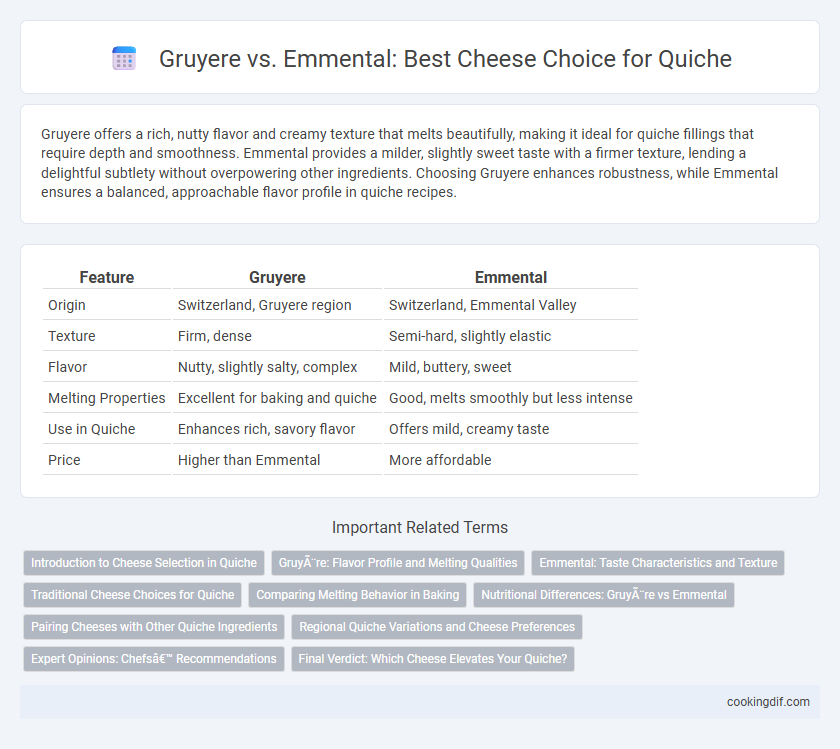Gruyere offers a rich, nutty flavor and creamy texture that melts beautifully, making it ideal for quiche fillings that require depth and smoothness. Emmental provides a milder, slightly sweet taste with a firmer texture, lending a delightful subtlety without overpowering other ingredients. Choosing Gruyere enhances robustness, while Emmental ensures a balanced, approachable flavor profile in quiche recipes.
Table of Comparison
| Feature | Gruyere | Emmental |
|---|---|---|
| Origin | Switzerland, Gruyere region | Switzerland, Emmental Valley |
| Texture | Firm, dense | Semi-hard, slightly elastic |
| Flavor | Nutty, slightly salty, complex | Mild, buttery, sweet |
| Melting Properties | Excellent for baking and quiche | Good, melts smoothly but less intense |
| Use in Quiche | Enhances rich, savory flavor | Offers mild, creamy taste |
| Price | Higher than Emmental | More affordable |
Introduction to Cheese Selection in Quiche
Gruyere and Emmental cheeses both play essential roles in quiche preparation, offering distinct textures and flavors that impact the final dish. Gruyere provides a rich, nutty taste with excellent melting qualities, ideal for achieving a creamy, smooth filling. Emmental, with its mild, slightly sweet flavor and characteristic holes, contributes a lighter texture and subtle sweetness, making it a popular choice for quiches aiming for a delicate balance of taste.
Gruyère: Flavor Profile and Melting Qualities
Gruyere cheese offers a rich, nutty flavor with slightly sweet undertones, making it ideal for enhancing the taste depth of quiche. Its superior melting qualities create a smooth, creamy texture that blends seamlessly with eggs and cream. Compared to Emmental, Gruyere provides a more robust and complex flavor, elevating the overall savory profile of the quiche.
Emmental: Taste Characteristics and Texture
Emmental cheese features a mild, slightly nutty flavor with a subtle sweetness that complements the savory richness of quiche without overpowering other ingredients. Its semi-hard texture melts smoothly, creating a creamy, cohesive filling that enhances the dish's overall mouthfeel. Emmental's characteristic holes contribute to even melting and aeration, resulting in a light and tender quiche crust.
Traditional Cheese Choices for Quiche
Gruyere and Emmental are traditional cheese choices for quiche, each imparting distinct flavors and textures. Gruyere offers a rich, nutty taste with excellent melting properties, creating a creamy and smooth filling. Emmental provides a milder, slightly sweet flavor and a firmer texture that adds a subtle bite to the quiche while maintaining its classic appeal.
Comparing Melting Behavior in Baking
Gruyere melts smoothly and evenly, creating a creamy texture that enhances quiche by offering rich, nutty flavors without separating or becoming greasy. Emmental, while also melting well, tends to release more oil and form a slightly stringy texture, which can affect the consistency of the quiche filling. Choosing Gruyere ensures a balanced melt and superior integration with eggs and cream, making it the preferred cheese for baked dishes like quiche.
Nutritional Differences: Gruyère vs Emmental
Gruyere cheese contains higher amounts of protein and calcium compared to Emmental, making it a more nutrient-dense choice for quiche fillings. Emmental offers slightly lower fat content and a milder flavor profile, which can influence the overall taste and texture of the quiche. Both cheeses provide essential nutrients like vitamin A and B12, but Gruyere's richer nutritional profile supports a heartier, creamier quiche experience.
Pairing Cheeses with Other Quiche Ingredients
Gruyere cheese offers a rich, nutty flavor and melts smoothly, making it ideal for pairing with savory ingredients like caramelized onions, spinach, and mushrooms in quiche. Emmental cheese has a milder taste and a slightly elastic texture, complementing sweeter elements such as ham, leeks, or sweet corn without overpowering them. Choosing Gruyere enhances earthy, robust fillings, while Emmental works well with lighter, subtly flavored combinations for a balanced quiche.
Regional Quiche Variations and Cheese Preferences
Gruyere and Emmental are key cheeses in regional quiche variations, with Gruyere favored in traditional French Quiche Lorraine for its rich, nutty flavor and excellent melting qualities. Emmental, known for its mild taste and distinctive holes, is preferred in some Swiss-inspired quiches, offering a slightly sweeter profile that complements lighter, herb-infused quiche fillings. Cheese selection directly influences the texture and authenticity of the quiche, reflecting regional cheese production and culinary heritage.
Expert Opinions: Chefs’ Recommendations
Chefs frequently recommend Gruyere over Emmental for quiche due to its rich, nutty flavor and superior melting qualities that create a creamy texture. Expert opinions highlight Gruyere's ability to elevate the dish with a balanced sharpness and complexity, whereas Emmental offers a milder, slightly sweet taste that may result in a less intense flavor profile. Professional chefs emphasize Gruyere's consistent performance and depth, making it the preferred choice for authentic, restaurant-quality quiches.
Final Verdict: Which Cheese Elevates Your Quiche?
Gruyere offers a rich, nutty flavor and creamy texture that melts beautifully, making it ideal for a custard-like quiche filling. Emmental delivers a milder, slightly sweet taste with excellent melting properties, providing a lighter, less intense cheese experience. For a quiche that prioritizes depth of flavor and a luxurious mouthfeel, Gruyere elevates the dish more effectively than Emmental.
Gruyère vs Emmental for cheese selection Infographic

 cookingdif.com
cookingdif.com